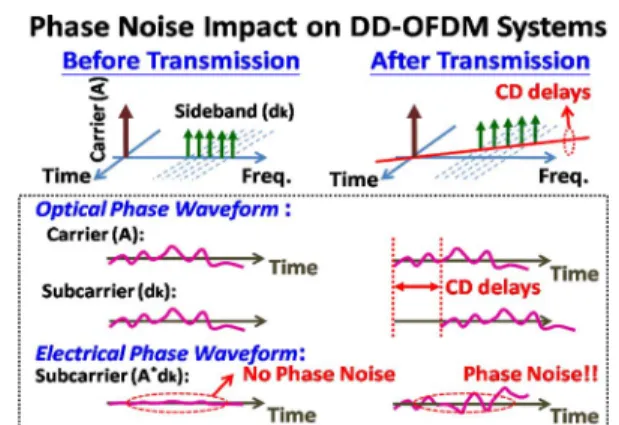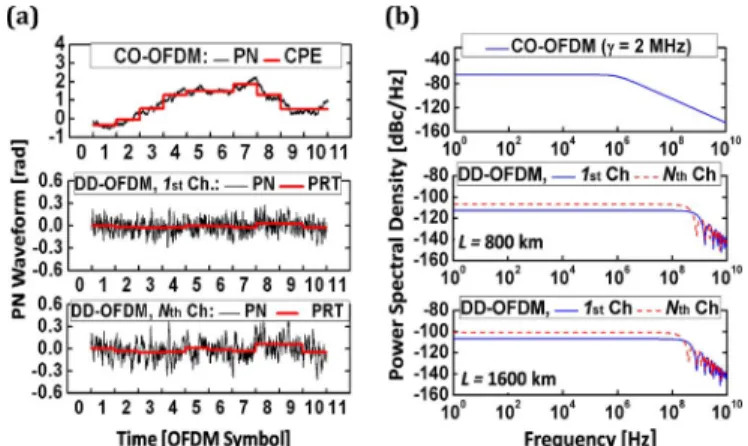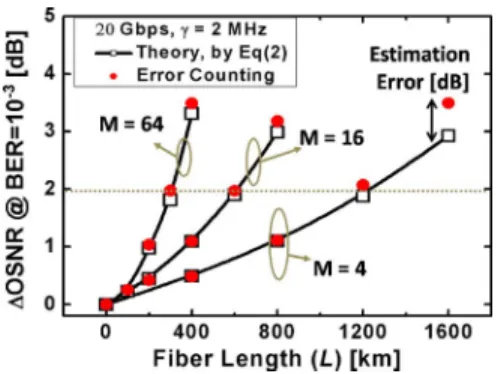IEEE PHOTONICS TECHNOLOGY LETTERS, VOL. 22, NO. 9, MAY 1, 2010 649
On the Phase Noise Impact in Direct-Detection
Optical OFDM Transmission
Wei-Ren Peng, Jason (Jyehong) Chen, and Sien Chi
Abstract—In this letter, we characterize the impact of
laser phase noise (PN) in direct-detection optical orthogonal frequency-division multiplexing (OFDM) and emphasize its sev-eral differences from those in coherent optical OFDM. We also analyze the system performance in the presence of PN for var-ious quadrature-amplitude-modulation formats and provide the bit-error-rate estimation method which can yield reliable results when the PN-induced optical signal-to-noise ratio penalty is lower than 2 dB.
Index Terms—Direct detection, optical fiber communication,
orthogonal frequency-division multiplexing (OFDM), phase noise (PN).
I. INTRODUCTION
O
PTICAL orthogonal frequency-division multiplexing(OFDM) has recently received much attention due to its flexible spectral efficiency and superior resilience against both fiber chromatic dispersion (CD) and polarization-mode dispersion (PMD) [1], [2]. To date, the OFDM systems could be implemented with either the coherent optical approach (CO-OFDM), or the direct-detection method (DDO-OFDM). DDO-OFDM, which uses the simpler hardware and the less-complex signal processing at a price of a worse receiving sensitivity when compared with CO-OFDM, would be an alternate format for next-generation metropolitan and long-haul terrestrial transmissions.
One claimed benefit of the DDO-OFDM systems is the relaxed requirement for the laser linewidth (LW): contrary to the high-cost external cavity laser (ECL) in CO-OFDM, a low-priced distributed-feedback (DFB) laser with a linewidth of several megahertz (MHz), in general, is considerably ac-ceptable in DDO-OFDM because of the better phase coherency between the carrier and sideband [3]. However, due to fiber CD, the carrier and the sideband will gradually walk off with the increasing transmission distance and eventually will lose their phase coherency causing significant phase noise (PN) in detection. This phenomenon had first been identified in [4] with 12.5-Gb/s [32-quadrature-amplitude modulation (QAM)] data rate and 320-km fiber transmission. However, the PN characteristics in DDO-OFDM systems, which are found to be
Manuscript received November 27, 2009; revised February 01, 2010; ac-cepted February 03, 2010. Date of publication February 22, 2010; date of current version April 09, 2010.
The authors are with Department of Photonics and Institute of Electro-Optical Engineering, National Chiao Tung University, HsinChu 300, Taiwan (e-mail: pwr.eo92g@nctu.edu.tw).
Color versions of one or more of the figures in this letter are available online at http://ieeexplore.ieee.org.
Digital Object Identifier 10.1109/LPT.2010.2042804
Fig. 1. Origin of PN in DDO-OFDM transmission.
quite different from those in CO-OFDM, should be clarified in detail and emphasized from a view point of system design.
In this letter, we find that the PN in DDO-OFDM has the following two significant differences from those in CO-OFDM: 1) the power and bandwidth of PN in DDO-OFDM are functions of both the subcarrier frequency and the trans-mission distance. Typically, a greater accumulated CD, i.e., the higher-frequency subcarrier with a longer transmission distance, would result in a larger PN power and a smaller PN bandwidth. Hence. the zeroth-order PN interference, previously the common phase error (CPE) [6], is no longer common to all subcarriers in DDO-OFDM. 2) The PN bandwidth, for most practical links, might range from hundred MHz to several gigahertz (GHz) which is independent of the laser LW. Such a broad spectrum will inevitably introduce significant intercarrier interference (ICI), making the PN compensator more difficult to design. On the other hand, in addition to the PN charac-terization, we also analyze the system performance with PN corruptions. The results show that, for a fixed data rate, even though the broader bandwidth of 4-QAM format would suffer the most accumulated CD, the larger symbol spacing could, however, provide a greater noise margin and make it most resilient against PN when compared with higher QAM formats. We also provide the bit-error-rate (BER) formula and, for the considered 4-, 16-, and 64-QAM formats, the estimated BERs are reliable provided the PN-induced optical signal-to-noise ratio (OSNR) penalty is 2 dB.
II. PN MODELING ANDBER
The PN origin in a DDO-OFDM system can be realized via Fig. 1. Before transmission, the carrier and sideband will be co-herent in phase such that there will be no PN after the photo-diode and thus no impact on the received signal. After transmis-sion, because of the relative walk-off, resulted from fiber CD, between the carrier and sideband, the PN will happen after the
650 IEEE PHOTONICS TECHNOLOGY LETTERS, VOL. 22, NO. 9, MAY 1, 2010
photodiode. Since the PN in DDO-OFDM comes from the inter-action between the laser LW and CD, the power and bandwidth of PN will be shown to be functions of both the subcarrier fre-quency and the transmission distance.
To understand this direct-detection PN more thoroughly, we quantify the PN with the following parameters: the laser PN is modeled by the Wiener process [5] with a variance of , where is the laser LW. Before transmission, the signal
with laser PN can be modeled as ,
where is the imaginary unit, and are the complex
amplitudes of the carrier and th data subcarrier [7], respec-tively, and represents the frequency of the th subcarrier. After transmission, the CD-induced walk-off will be in-volved into the signal model which now has a form of
, where is
the relative time delay of the th subcarrier with respect to the
carrier and can be expressed as , of which
is the light speed in vacuum, is the dispersion parameter, is the fiber length, and is the operated wavelength. Then the th subcarrier after the photodiode can be expressed as
, where takes the
real part of , the superscript “ ” carries out the complex
conju-gation, and stands for the converted
electrical PN in DDO-OFDM systems [8]. After the fast Fourier transform (FFT) demodulator, the th subcarrier signal can be
represented as [5], [6]
with , where is
the FFT size and is the timely sampled function of . Note that the zeroth-order PN , conventionally CPE in CO-OFDM, is a function of the subcarrier index (frequency) and, therefore, its value is no longer common to all the data subcarriers. Thus, we rename simply as “phase rotation term (PRT)” here because typically it induces only the symbol rotation when PN is small [5], [6]. For DDO-OFDM, the received subcarrier signal has a similar form as its wireless analogy [5], with the following extra assumptions: 1) PN of the signal–signal beat interference (SSBI) [7] is relatively small and can be omitted; 2) the PN-to-amplitude noise is negligible, which usually is true when the sideband is far from the carrier.
Now we obtain the electrical signal-to-noise ratio (ESNR) and BER by assuming that ICI from adjacent subcarriers are all independent and Gaussian-distributed [5]. The ESNR, without considering the PRT, , could be approximated as
(1)
where ESNR is the ESNR of th subcarrier with only
the amplified spontaneous emission (ASE) noise [7]. The BER, with 4-QAM format, for each subcarrier should consider both the phase rotation of PRT and the Gaussian-noise terms of ASE and ICI, and can be obtained as follows [5]:
(2)
where is the random phase rotation and is Gaussian
distributed with a variance of . The system BER can then be obtained by taking the average of BER [7]. Notably, the
Fig. 2. (a) PN waveforms versus OFDM symbols for CO- and DDO-OFDM systems. (b) Power spectral density (PSD) of PN. Top: CO-OFDM. Center: DDO-OFDM with 800-km SSMF. Bottom: DDO-OFDM with 1600-km SSMF.N = 160.
BER with higher QAM formats can be easily derived in a similar manner [5].
III. NUMERICALRESULTS ANDDISCUSSION
In simulations, we consider the typical gapped-OFDM transmission [1] with 20-Gb/s data rate, 160 data subcarriers, 1024 FFT size, 20% cyclic prefix, 2-MHz laser LW, and 16-ps/(nm.km) dispersion parameter for transmission fiber. The second-order Gaussian optical filters are used with a 3-dB bandwidth equal to 1.2 (signal bandwidth). In Figs. 2 and 3, we first compare the PN characteristics of the CO- and DDO-OFDM systems with 16-QAM format. In Fig. 2(a),
we show the PN waveforms of and for the
CO-and DDO-OFDM systems, respectively, with 1600-km fiber transmission. For DDO-OFDM, we show the results of both the 1st and 160th subcarriers to emphasize the frequency dependency. The larger PN variance in CO-OFDM is observed because of the random walk nature of the Wiener process, which allows the phase to travel unlimitedly with increasing time. On the other hand, the PN power of DDO-OFDM will
be constrained by its variance of and thus would
not go unboundedly. Also, in DDO-OFDM, the PN power of 160th subcarrier is twice as large as that of the first subcarrier due to the doubled accumulated CD. In Fig. 2(b), we show the PNs’ PSD, which are analytically provided in [8], for both the CO- and DDO-OFDM systems. For DDO-OFDM, the results of the 1st and 160th subcarriers are shown with 800-and 1600-km fiber transmission. The one-sided 3-dB PN b800-and- band-width of DDO-OFDM ( 174 MHz for 160th subcarrier with 1600-km transmission) is found to be much broader than that of CO-OFDM ( 1 MHz), and be a function of both the subcarrier frequency and the transmission distance. Typically, a higher subcarrier frequency (i.e., 160th subcarrier) with a longer transmission distance (i.e.,1600 km) would result in a larger PN power and a narrower PN bandwidth. In Fig. 3, we further show the received constellations for CO- and DDO-OFDM systems with 1600-km transmission. For CO-OFDM, the CPE has a relatively larger power than ICI and would strongly rotate the subcarrier phase so that the CPE compensator is a must at the receiver [6]; while for DDO-OFDM, although the PRT would similarly degrade the signal by introducing some phase deviations, due to its broader PN bandwidth, the ICI shows a
PENG et al.: ON THE PN IMPACT IN DIRECT-DETECTION OPTICAL OFDM TRANSMISSION 651
Fig. 3. Effects of PRT and ICI on 16-QAM format in both CO- and DDO-OFDM systems. = 2 MHz, N = 160, L = 1600 km.
Fig. 4. BER versus OSNR with different transmission distances.
relatively larger power and has a more significant impact on the signal quality.
In Fig. 4, the BER performance in terms of OSNR, obtained by the error counting (EC) method, are shown for DDO-OFDM systems in the presence of PN. The 4-QAM format is utilized in systems with different transmission lengths of 0, 500, 1000, and 1500 km. The theoretical estimations of (2) are also shown for comparisons. The OSNR penalty is found to be enlarged with an increasing fiber length , and the BER floor could be found when is 1000 km. The estimations by (2) are found to match the EC results only when the PN power is relatively smaller, i.e., under the conditions of either a higher OSNR value or a shorter transmission distance. When the PN power becomes larger, (2) will fail to yield an accurate BER. This inaccuracy could be attributed to the pattern effect of the subcarrier signal [9], which needs exhausted and almost prohibitive computations and thus is not considered in (2).
In Fig. 5, we investigate the OSNR penalty versus transmis-sion distance with diverse QAMs. Again both the EC results and the estimations (2) are compared. First of all, from the EC results, the maximum distance of 4-, 16- and 64-QAM formats with 2-dB OSNR penalty are found to be 1200, 600, and 300 km, respectively, which demonstrates that the 4-QAM format, which exhibits a larger noise margin with the sacrifice in spectral efficiency, has a better PN tolerance achieving a longer transmission distance. Note that here the different QAMs are switched with a fixed data subcarrier number, while similar results will be obtained if the QAMs are switched with a fixed OFDM symbol duration. Then, from the theoretical estimations, we found the estimations by (2) would deviate from the exact EC results when the OSNR penalty is
Fig. 5. OSNR penalty versus fiber length for 4-, 16-, and 64-QAMs.
large. If the maximum estimation error, which is defined as, given a fiber distance , the penalty difference between the EC results and the estimations by (2), is allowed to be 0.2 dB, we found that (2) can offer an acceptable estimation for both 16-and 64-QAM formats when the OSNR penalty is up to 3 dB; while for the 4-QAM format which suffers stronger PN, (2) can still yield a reliable estimation when the OSNR penalty is 2 dB. This demonstrates that (2) can reliably estimate the OSNR penalty when the OSNR penalty is 2 dB for all the considered QAM formats.
In conclusion, based on the discussions above, the previous CPE compensator [6], which ignores the ICI effect, would inef-ficiently assist in recovering the PN-corrupted signals in OFDM. On the other hand, the broader PN bandwidth in DDO-OFDM would make the RF-pilot compensator [2], [5], which needs a frequency guard band with a width of approximately the PN bandwidth, a less spectrally efficient method. There-fore, the PN in DDO-OFDM might motivate a new PN solution for high-capacity and long-distance transmission that uses DFB lasers.
REFERENCES
[1] B. J. C. Schmidt, A. J. Lowery, and J. Armstrong, “Experimental demonstrations of electronic dispersion compensation for long-haul transmission using direct-detection optical OFDM,” J. Lightw.
Technol., vol. 26, no. 1, pp. 196–203, Jan. 1, 2008.
[2] S. L. Jansen, I. Morita, T. C. W. Schenk, N. Takeda, and H. Tanaka, “Coherent optical 25.8 Gb/s OFDM transmission over 4160-km SSMF,” J. Lightw. Technol., vol. 26, no. 1, pp. 6–15, Jan. 1, 2008. [3] D. Qian, J. Yu, J. Hu, L. Zong, L. Xu, and T. Wang, “10 Gb/s
WDM-SSB-OFDM transmission over 1000 km SSMF using conven-tional DFB lasers and direct-detection,” Electron. Lett., vol. 44, no. 3, pp. 223–225, Jan. 2008.
[4] Z. Zan, M. Premaratne, and A. J. Lowery, “Laser RIN and linewidth requirements for direct detection optical OFDM,” in Proc. CLEO’08, San Jose, Paper CWN2.
[5] M. S. El-Tanany, Y. Wu, and L. Hazy, “Analytical modeling and sim-ulation of phase noise interference in OFDM-based digital television terrestrial broadcasting systems,” IEEE Trans. Broadcasting, vol. 47, no. 1, pp. 20–31, Mar. 2001.
[6] X. Yi, W. Shieh, and Y. Ma, “Phase noise effects on high spectral effi-ciency coherent optical OFDM systems,” J. Lightw. Technol., vol. 26, no. 10, pp. 1309–1316, May 15, 2008.
[7] W.-R. Peng, K.-M. Feng, A. E. Willner, and S. Chi, “Estimation of the bit error rate for direct-detected OFDM signals with optically pre-am-plified receivers,” J. Lightw. Technol., vol. 27, no. 10, pp. 1340–1346, May 15, 2009.
[8] G. Qi, J. Yao, J. Seregelyi, S. Paquet, C. Belisle, X. Zhang, K. Wu, and R. Kashyap, “Phase-noise analysis of optically generated millimeter-wave signals with external optical modulation techniques,” J. Lightw.
Technol., vol. 24, no. 12, pp. 4861–4875, Dec. 2006.
[9] R. Corvaja and S. Puolin, “Phase noise spectral limits in OFDM sys-tems,” Wireless Personal Commun., vol. 36, pp. 229–244, 2006.


